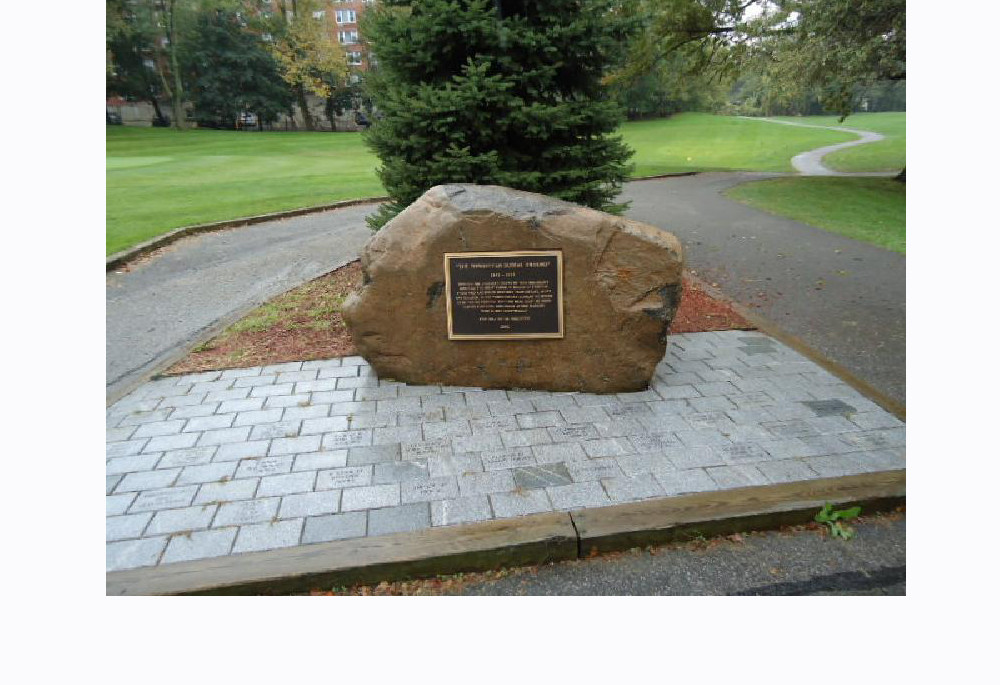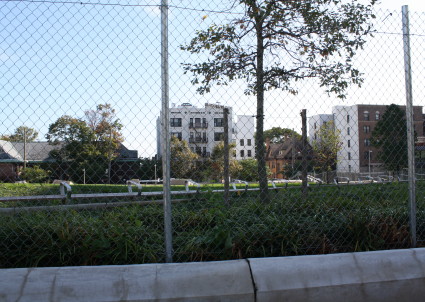New York Marine Hospital or “Quarantine” gravesites,
established 1799-1858
two sites: Central Avenue and Hyatt Street, Tompkinsville; inside Silver Lake Golf Course, Silver Lake
Long before Ellis Island (established in 1892) became a hub for immigrants seeking to settle in the United States, officials would inspect newcomers on-board their vessels in the harbor. Those who were determined to be ill were sent to Staten Island for treatment. The New York Marine Hospital, or “Quarantine,” was a 20-building complex just south of today’s St. George Terminal. The hospital sought to protect the city from immigrant-borne infectious diseases, such as yellow fever, typhus, small pox and cholera. The hospital, in operation from 1799 to 1858, could hold as many as 1,500 people at a time. Shanty towns cropped up on the north shore of Staten Island, housing healthy relatives awaiting the return of loved ones. Hospital patients who died were buried in several locations, two of which are known today to be at the intersection of Central Avenue and Hyatt Street in St. George (pictured on this page) and within the Silver Lake Golf Course, where a monument to the gravesite is located near the clubhouse (pictured on opposite page). These two sites do not have extant grave markers, and are not discernible as cemeteries. However, they are very significant both due to the tens of thousands of people buried in mass graves here, and the important link they provide to New York City’s history as a gateway for millions of immigrants from the 18th to the 20th centuries.
The hospital had been established by the state, the land taken by eminent domain, thus leading to much resentment by Staten Island residents. The hospital, considered a blight on this rural farming community, endangered those who lived here, with deadly outbreaks of Yellow Fever occurring periodically. These epidemics became more common in the 1840s and 1850s, when immigration increased due to huge numbers of Irish famine victims arriving in the city. It was at this time that locals began campaigning to destroy the hospital. On September 1, 1858, the local board of health resolved that the hospital should be destroyed, and that very night, locals torched the hospital to the ground. The act was spearheaded by John Thompson and Ray Tompkins, a prosperous landowner whose grandfather, Daniel, was Vice President of the United States under James Monroe (Tompkinsville was also named after him). It is believed that the hospital administrator, Dr. Richard Thompson, negotiated to spare the Female Hospital, where the 60 patients on the grounds were relocated during the fire. Authorities generally turned a blind eye. The following evening, the rest of the campus was destroyed by a second fire. There were no casualties, though the two leaders were put on trial. Judge Henry Metcalfe, who lived near the hospital and had a relative who was a victim of Yellow Fever, acquitted both men.
In 2003, the State of New York began an eight-year process of locating and reinterring the cemetery, exhuming a portion of one of the Marine Hospital gravesites when work began on a new courthouse complex in St. George. Once the cemetery was exhumed, the remains were housed at Moravian Cemetery until April 27, 2014, when FACSI and the American Irish Legislators Society of New York State conducted a memorial reinterment service for the permanent entombment of these immigrants, more than 150 years after their tragic deaths.

